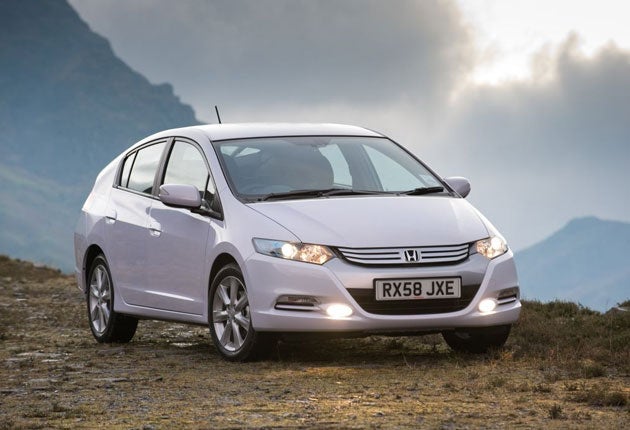Honda Insight
Digital dashboard trees – with leaves that fall off – let the new, eco-friendly Honda show you how green your driving is

Your support helps us to tell the story
From reproductive rights to climate change to Big Tech, The Independent is on the ground when the story is developing. Whether it's investigating the financials of Elon Musk's pro-Trump PAC or producing our latest documentary, 'The A Word', which shines a light on the American women fighting for reproductive rights, we know how important it is to parse out the facts from the messaging.
At such a critical moment in US history, we need reporters on the ground. Your donation allows us to keep sending journalists to speak to both sides of the story.
The Independent is trusted by Americans across the entire political spectrum. And unlike many other quality news outlets, we choose not to lock Americans out of our reporting and analysis with paywalls. We believe quality journalism should be available to everyone, paid for by those who can afford it.
Your support makes all the difference.'Ecolution," enunciated the Honda Europe spokesman with Germanic elocution. "Think of evolution and revolution. But not pollution, please." He was talking about Honda's new eco-friendly hybrid, the car that looks like a Toyota Prius but will cost less.
The new, high-tailed Honda Insight, named after the ultra-light hybrid coupé of a decade ago, would seem radical had not Toyota already defined the genre, but even as it is we should be glad that this Honda hybrid doesn't look as forgettable as the former Civic Hybridsaloon. Instead, it's visually a smaller version of the hydrogen-powered Honda FCX Clarity. The idea is to make hybrids more affordable than they have been, so more buyers will make the leap into the technology of the future. The Civic Hybrid bowed out in the mid-£16,000s and a Prius is more than £17,000, so we can expect the Insight to cost around £15,000 when prices are announced in early March.
Technology always gets cheaper with time, but how has it happened here? Mainly by making the hybrid parts simpler, lighter and smaller. More costs were saved by basing the suspension, steering and part of the structure on those of the new Jazz supermini, although the Insight is a bigger car.
It's also one compromised by the need to appeal to diverse world markets. The Americans would have preferred a saloon with a separate boot, but to emphasise the futurism and suit most European buyers' needs, Honda opted for a five-door hatchback body. Thanks to that high tail, the battery and control unit can be placed under the boot floor and still leave room for a decent boot and fold-down seats.
Sit inside the Insight and it's clear where more cost was cut. Nearly every non-upholstered surface is formed from hard, unyielding plastic. Americans accept this but Europeans will flinch.
If you're driving economically, the background to the digital speedometer in the upper display is green. Be profligate with the fuel or brake too hard and the background turns through turquoise to blue.
There's more. This is the car as Tamagotchi: five tree trunks occupy a lower display, and within 100 yards of setting off it will place leaves on these trees according to your light-footedness. If you're gentle, all five trees will get two leaves each, which may drop off if your right foot gets heavier. If you screech off in scorched-earth fashion, you might get just one leaf until you calm down. Continue driving in eco-mindset, and you'll be rewarded with new rows of leaves. Thrash the Insight to death, and the leaves fall off. Below the forest is a graphic in which a flag-like symbol extends to left (braking) or right (acceleration); to be an eco-driver you need to keep the flag out of hatched areas.
Fine. So what is the Insight like to drive? It can move off on electricity alone, during which time the engine's valves are shut and it is passively rotated almost without resistance. Then the engine smoothly joins in, the combined output sent through a continuously variable transmission which lets the engine speed soar noisily more often than it should. Or you can use paddles on the steering wheel to perform rather ill-defined "manual" shifts through seven virtual gear ratios.
And there's an Econ button, which smoothes the surges caused by an overactive accelerator foot. In practice, you feel little difference unless you are an innately abrupt driver. The Insight steers anaesthetically but adequately, is a touch choppy over bumps, and brakes firmly and naturally even though up to 60 per cent of braking effort comes from the regenerative braking which uses the absorption of kinetic energy to recharge the battery via the motor. And once the Insight stops, the engine stops too.
Honda says the Insight gives genuine fuel economy. My brisk drive resulted in 42mpg which a turbodiesel could have matched. The Insight, at 101g/km CO2 is a good answer to the CO2-reduction issue. But it's not the only one.
Join our commenting forum
Join thought-provoking conversations, follow other Independent readers and see their replies
Comments